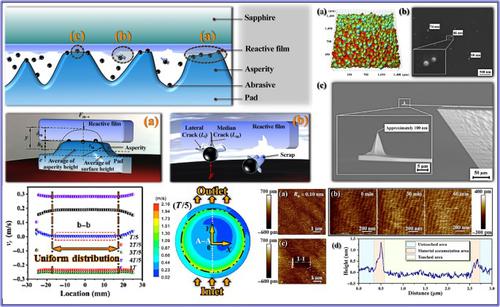Friction ( IF 6.3 ) Pub Date : 2023-02-23 , DOI: 10.1007/s40544-022-0713-7 Mufang Zhou , Min Zhong , Wenhu Xu

|
Ultrasonic-assisted chemical mechanical polishing (UA-CMP) can greatly improve the sapphire material removal and surface quality, but its polishing mechanism is still unclear. This paper proposed a novel model of material removal rate (MRR) to explore the mechanism of sapphire UA-CMP. It contains two modes, namely two-body wear and abrasive-impact. Furthermore, the atomic force microscopy (AFM) in-situ study, computational fluid dynamics (CFD) simulation, and polishing experiments were conducted to verify the model and reveal the polishing mechanism. In the AFM in-situ studies, the tip scratched the reaction layer on the sapphire surface. The pit with a 0.22 nm depth is the evidence of two-body wear. The CFD simulation showed that abrasives could be driven by the ultrasonic vibration to impact the sapphire surface at high frequencies. The maximum total velocity and the air volume fraction (AVF) in the central area increased from 0.26 to 0.55 m/s and 20% to 49%, respectively, with the rising amplitudes of 1–3 µm. However, the maximum total velocity rose slightly from 0.33 to 0.42 m/s, and the AVF was nearly unchanged under 40–80 r/min. It indicated that the ultrasonic energy has great effects on the abrasive-impact mode. The UA-CMP experimental results exhibited that there was 63.7% improvement in MRR when the polishing velocities rose from 40 to 80 r/min. The roughness of the polished sapphire surface was Ra = 0.07 nm. It identified that the higher speed achieved greater MRR mainly through the two-body wear mode. This study is beneficial to further understanding the UA-CMP mechanism and promoting the development of UA-CMP technology.
中文翻译:

蓝宝石超声波辅助化学机械抛光材料去除率的新模型
超声波辅助化学机械抛光(UA-CMP)可以极大地提高蓝宝石材料去除率和表面质量,但其抛光机理仍不清楚。本文提出了一种新的材料去除率(MRR)模型来探索蓝宝石UA-CMP的机理。它包含两种模式,即二体磨损和磨料冲击。此外,还进行了原子力显微镜(AFM)原位研究、计算流体动力学(CFD)模拟和抛光实验来验证模型并揭示抛光机制。在AFM原位研究中,尖端划伤了蓝宝石表面的反应层。深度为0.22 nm的凹坑是二体磨损的证据。CFD模拟表明,磨料可以在超声波振动的驱动下以高频冲击蓝宝石表面。中心区域的最大总速度和空气体积分数(AVF)分别从0.26增加到0.55 m/s和20%增加到49%,上升幅度为1-3 µm。然而,最大总速度从0.33略有上升至0.42 m/s,并且AVF在40-80 r/min下几乎没有变化。这表明超声波能量对磨料冲击模式影响很大。UA-CMP实验结果表明,当抛光速度从40 r/min升至80 r/min时,MRR提高了63.7%。蓝宝石表面抛光后的粗糙度为Ra = 0.07 nm。研究发现,较高的速度主要通过二体磨损模式实现更大的MRR。本研究有利于进一步认识UA-CMP机理,推动UA-CMP技术的发展。











































 京公网安备 11010802027423号
京公网安备 11010802027423号